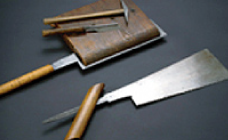Saw [nokogiri]
Saw
Saw

Dotsuki-no-ko (one blade) / horizontal grinding
The saw blade is thin and reinforced with back money. The teeth are fine, and the ground skin is smooth and suitable for precise processing. Used for kumite processing of elaborate small work. 8 inch to shaku is normal.

Azebikinoko/double blade
Both blades are a combination of kamoi-biki and han-biki, which became popular after the Meiji period, and today, han-biki refers to two blades. Since it is used when processing holes in the middle of the member, the blade is short and curved. 2 inch to 3 inch and 5 minutes is normal.

Kamoibikinoko, one blade, vertical grinding
It decreased sharply due to the emergence of double-edge bunji. It is used for processing grooves in Kamoi or for spinning the back of pillars. Large items (6 inches to 7 inches) are also called 'shinbiki' or 'tobowari.' 4 inch to 5 inch is normal.

Hikimawashinoko (one blade) / horizontal grinding
A type of mawashi grinding. It is used to process the penetration part with curves on board material. Pull it and use it. 6 inch to shaku is normal.

Tsukimawashinoko (one blade) / horizontal grinding
A type of mawashi grinding. It has the same function as a grinding saw, and press it to use. 6 inch to 8 inch is normal.

Ranmabikinoko (one blade) / horizontal grinding
It is very small in grinding and has fine teeth. Used for precise processing. 3 to 5 sun is normal.

Basic information
Special Exhibition
Permanent exhibition